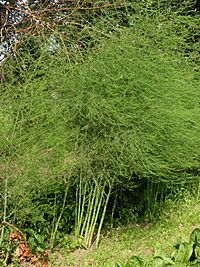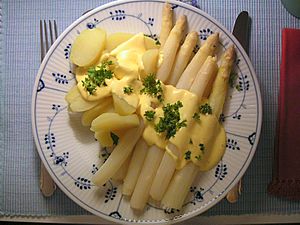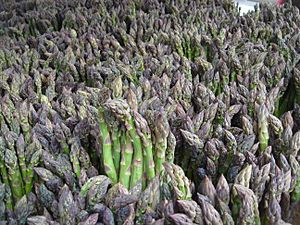Garden asparagus facts for kids
Quick facts for kids Asparagus |
|
|---|---|
 |
|
| Asparagus officinalis plants. | |
| Scientific classification | |
| Kingdom: | |
| Division: | |
| Class: | |
| Order: | |
| Family: | |
| Genus: |
Asparagus
|
Asparagus is a large group of flowering plants with over 300 different kinds, called species. Some of these plants are grown just for their beauty, like the "asparagus fern" (Asparagus setaceus). Even though it's called a fern, it's not a real one! The most famous plant in this group is Asparagus officinalis. This is the one we eat as a vegetable, usually in the spring.
Some types of asparagus are used in cooking all over the world.
Contents
All About Asparagus
| Nutritional value per 100 g (3.5 oz) | |
|---|---|
| Energy | 85 kJ (20 kcal) |
|
3.88 g
|
|
| Sugars | 1.88 g |
| Dietary fibre | 2.1 g |
|
0.12 g
|
|
|
Protein
|
2.2 g
|
| Vitamins | Quantity
%DV†
|
| Vitamin A equiv.
beta-Carotene
lutein zeaxanthin
|
5%
38 μg
4%
449 μg710 μg
|
| Thiamine (B1) |
12%
0.143 mg |
| Riboflavin (B2) |
12%
0.141 mg |
| Niacin (B3) |
6%
0.978 mg |
| Pantothenic acid (B5) |
5%
0.274 mg |
| Vitamin B6 |
7%
0.091 mg |
| Folate (B9) |
13%
52 μg |
| Choline |
3%
16 mg |
| Vitamin C |
7%
5.6 mg |
| Vitamin E |
7%
1.1 mg |
| Vitamin K |
40%
41.6 μg |
| Minerals | Quantity
%DV†
|
| Calcium |
2%
24 mg |
| Iron |
16%
2.14 mg |
| Magnesium |
4%
14 mg |
| Manganese |
8%
0.158 mg |
| Phosphorus |
7%
52 mg |
| Potassium |
7%
202 mg |
| Sodium |
0%
2 mg |
| Zinc |
6%
0.54 mg |
|
Link to USDA Database entry
|
|
| †Percentages estimated using US recommendations for adults. | |
We usually only eat the young asparagus shoots. Once the buds start to open, the shoots quickly become tough and woody.
Asparagus is mostly water, about 93%! It's also low in calories and has very little sodium. It's a great source of many good things for your body. These include vitamin B6, calcium, magnesium, and zinc. It also has lots of fiber, protein, beta-carotene, vitamin C, vitamin E, and vitamin K. Other important nutrients are thiamin, riboflavin, rutin, niacin, folic acid, iron, phosphorus, potassium, copper, manganese, and selenium. It even has chromium, which helps your body use sugar. The amino acid called asparagine is named after asparagus because the plant has a lot of it.
How Asparagus is Cooked
Asparagus shoots are prepared in many ways around the world. They are often served as a starter or a side dish with a meal. In Asian cooking, asparagus is often stir-fried. For example, Cantonese restaurants in the United States often stir-fry asparagus with chicken, shrimp, or beef.
You can also quickly grill asparagus over hot coals. It's sometimes used in stews and soups too. Lately, eating raw asparagus in a salad has become popular again. Asparagus can also be pickled to keep it fresh for several years. Some brands call these "marinated" asparagus.
The thickness of an asparagus stem tells you how old the plant is. Thicker stems come from older plants. Older, thicker stalks can be woody. You can peel the skin at the bottom to remove the tough part. Peeled asparagus cooks much faster. The bottom part of asparagus often has sand or soil, so it's a good idea to wash it well before cooking.
Green asparagus is eaten worldwide. It used to be a special treat, but now you can find it almost all year because it's imported. In Europe, the "asparagus season" is a big deal for people who love food. In the UK, it usually starts on April 23 and ends on Midsummer Day. Because it only grows for a short time and people want local produce, asparagus can be quite expensive.
White Asparagus in Europe

Asparagus is very popular in many European countries like the Netherlands, Germany, and Italy. In these places, it's almost always white. If it's green, they will say "green asparagus" specifically. White asparagus is grown by covering the shoots with soil as they grow. This means they don't get any sunlight, so they can't make photosynthesis and stay white.
People believe white asparagus, sometimes called "white gold" or "edible ivory," is less bitter and more tender than green asparagus. It's also known as "the royal vegetable." It's very important for white asparagus to be fresh. The lower ends must be peeled before you cook or eat them raw.
Asparagus dishes are often advertised outside restaurants from late April to June, when it's in season. In France, asparagus is often boiled or steamed. It's served with Hollandaise sauce, melted butter, olive oil, Parmesan cheese, or mayonnaise. There are even special tall, narrow pots for cooking asparagus. These pots let the tips steam gently while the rest of the stalk is in the water.
Growing Asparagus
Asparagus often grows well near the sea, so it likes salty soil. This kind of soil is too salty for most weeds to grow. Because of this, people used to put a little salt on asparagus beds to stop weeds. However, this means you can't grow anything else in that soil later. Some places are better for growing asparagus than others, and good soil is very important.
Asparagus "crowns" (the root part) are planted in winter. The first shoots appear in spring. The very first thin shoots that are picked are called sprue asparagus.
A new type of "early season asparagus" was announced in 2011. This kind can be harvested two months earlier than usual. It doesn't need to rest during winter and starts growing at 7°C (45°F) instead of the usual 9°C (48°F).
Types of Asparagus
Purple asparagus is different from green and white types. It has more sugar and less fiber. Purple asparagus was first grown in Italy, near the city of Albenga. It was sold under the name 'Violetto d'Albenga'. Since then, new types like 'Pacific Purple' have been created in the United States and New Zealand.
Companion Planting
Asparagus is a good companion plant for tomatoes. This means they help each other grow. Tomato plants can keep away the asparagus beetle, which can harm asparagus. Asparagus might also help keep away some tiny worms (nematodes) that can hurt tomato plants' roots.
Asparagus Around the World
In 2013, the United States bought the most asparagus from other countries. The European Union and Canada also bought a lot.
China is by far the biggest producer of asparagus in the world. In 2013, China grew 7,000,000 tonnes. Peru was second, and Mexico was third. In the U.S., most asparagus is grown in California, Michigan, and Washington. Germany produces 57,000 tonnes of white asparagus each year. This meets about 61% of what people there want to eat.
When asparagus is grown inside tunnels, farmers can make the growing season longer. In Britain, asparagus grown in tunnels can be harvested from February to November.
Images for kids
-
Three types of asparagus are on display, with white asparagus at the back and green asparagus in the middle. The plant at the front is Ornithogalum pyrenaicum, commonly called wild asparagus, and sometimes "Bath asparagus".
-
Wild asparagus (Asparagus aphyllus) native to the Levant
-
Mature wild asparagus with seed pods in Saskatchewan, Canada
See also
 In Spanish: Asparagus officinalis para niños
In Spanish: Asparagus officinalis para niños

















